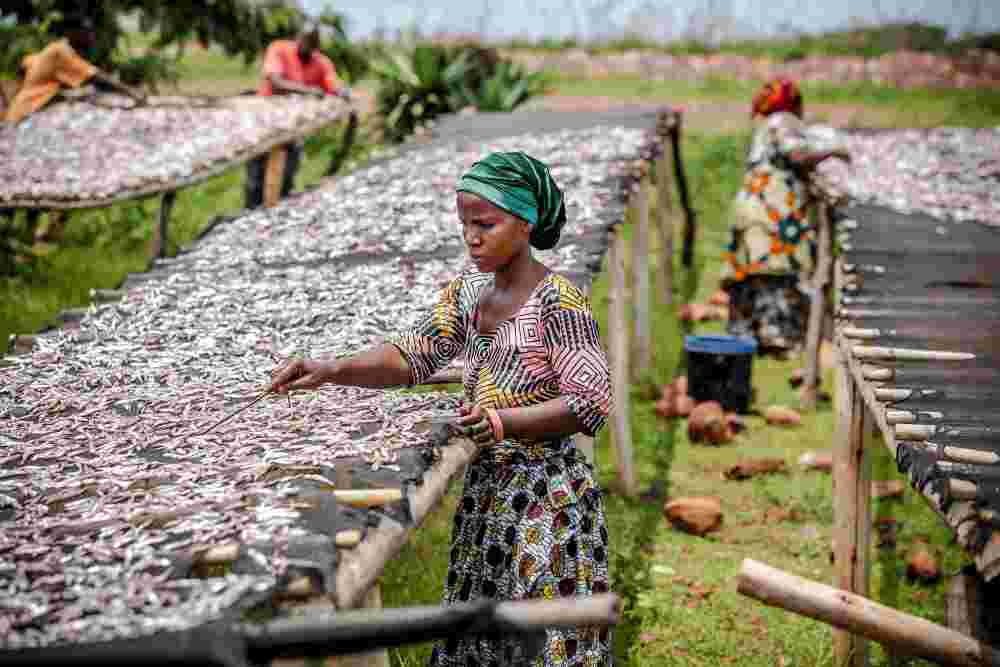Empowering Women in Small-Scale Fisheries for Sustainable Food Systems (2020-2021)
Ghana, 2020 - 2023
Get Microdata
Reference ID
GHA_2020-2021_EWSFSFS_v01_EN_M_v01_A_OCS
Producer(s)
Nicole Franz, Lena Westlund, Molly Ahern
Collections
Metadata
Created on
Feb 09, 2023
Last modified
Mar 10, 2023
Page views
54049
Downloads
524
1.6.5 Why did you lose/throw away fish? (x1_6_5_why_did_you_lose_thro)
Data file: data_anon_focus_groups_discussions
Overview
Valid:
38
Type:
Discrete
Width:
230
Range:
-
Format:
character
Questions and instructions
Categories
| Value | Category | Cases | |
|---|---|---|---|
| Basically breakage depends on the quality of the fresh fish. We sell breakages as animal feed | 1 |
2.6%
|
|
| Because the fire out breaks or unattended kilns,. If we have more fresh fish than we can handle the fish goes bad | 1 |
2.6%
|
|
| Because fish developed fungus and some got broken into pieces | 1 |
2.6%
|
|
| Because of over cooking, fish got burnt during smoking, some developed worms and others were infected with fungus | 1 |
2.6%
|
|
| Because production volume was too much to handle some of the fish get burnt or it got moldy from storage | 1 |
2.6%
|
|
| Because the fish got mashed up | 1 |
2.6%
|
|
| Due to breakages | 1 |
2.6%
|
|
| Dynamite was used to harvest the fish which rendered the fish unsafe for consumption | 1 |
2.6%
|
|
| Fire outbreaks is caused by fish fats and can be unpredictable. If too dry the fish becomes brittle, if the moisture level is high | 1 |
2.6%
|
|
| Fish gets spoilt | 1 |
2.6%
|
|
| Fish got Burnt | 1 |
2.6%
|
|
| Fish got burnt and others got rotten due to parasites infections | 1 |
2.6%
|
|
| Fish got burnt and some got broken during transportation to market | 1 |
2.6%
|
|
| Fish got burnt during smoking | 2 |
5.3%
|
|
| Fish got mashed up during loading into the cargo track | 1 |
2.6%
|
|
| Fish was badly broken into pieces during transportation to market | 1 |
2.6%
|
|
| Fish was badly burnt during processing | 1 |
2.6%
|
|
| Fish was bought spoilt unknowingly from the fisherman, sometimes it breaks in the process of transporting | 1 |
2.6%
|
|
| Fish was burnt | 1 |
2.6%
|
|
| Fish was burnt Fish was smashed during transportation | 1 |
2.6%
|
|
| Fishes got burnt during smoking | 1 |
2.6%
|
|
| Glut in the market | 1 |
2.6%
|
|
| If the fish is soggy, after processing ,the fish breaks into fragments and are sold at a reduced price to poultry farmers. There are insects infestation as well | 1 |
2.6%
|
|
| If they are not well stored they could go mouldy and sometimes there is insect infestation | 1 |
2.6%
|
|
| Market was very bad and I needed money to purchase another consignment the following day | 1 |
2.6%
|
|
| NA | 2 |
5.3%
|
|
| No | 1 |
2.6%
|
|
| Spoilage of the fresh fish and Breakages and this sold for animal feed | 1 |
2.6%
|
|
| The fish was burnt so I threw them away | 1 |
2.6%
|
|
| The quality of fresh fish is bad, if storage is poor, oily fish, fire outbreaks, poor packaging during transportation. The broken pieces of processed are sold off as animal feed. Bad fresh fish is processed into fermented products | 1 |
2.6%
|
|
| There could be oil in the fish which could go rancid unknowingly during storage | 1 |
2.6%
|
|
| There was a lot of fat in the fish, storage was poorly done | 1 |
2.6%
|
|
| There was spoilage before processing and they broke into fragments | 1 |
2.6%
|
|
| We did not have a cold facility to store excess fish | 1 |
2.6%
|
|
| We do not throw fish away. | 1 |
2.6%
|
|
| Worms infestation | 1 |
2.6%
|
Warning: these figures indicate the number of cases found in the data file. They cannot be interpreted as summary statistics of the population of interest.
